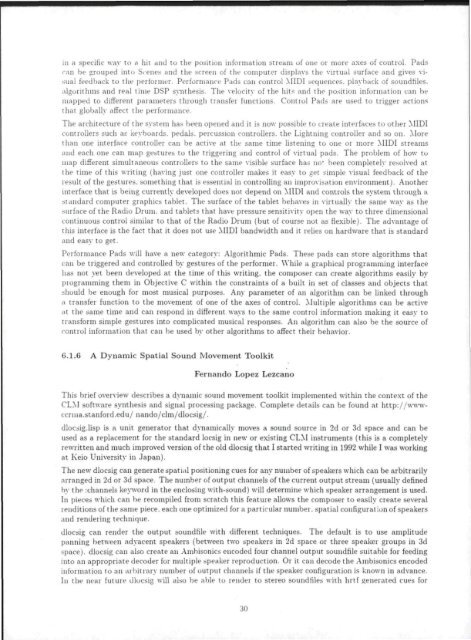Download - CCRMA - Stanford University
Download - CCRMA - Stanford University
Download - CCRMA - Stanford University
Create successful ePaper yourself
Turn your PDF publications into a flip-book with our unique Google optimized e-Paper software.
in a specific way to a hit and to the position information stream of one or more axes of control. Pads<br />
ran be grouped into Scenes and the screen of the computer displays the virtual surface and gives visual<br />
feedback to the performer. Performance Pads can control MIDI =.equences. playback of soundhles.<br />
algorithms and real time DSP synthesis. The velocity' of the hits and the position information can be<br />
mapped to different parameters through transfer functions. Control Pads are used to trigger actions<br />
that globally affect the performance.<br />
The architecture of the system has been opened and it is now possible to create interfaces to other MIDI<br />
controllers such as keyboards, pedals, percussion controllers, the Lightning controller and so on. More<br />
than one interface controller can be active at the same time listening to one or more MIDI streams<br />
and each one can map gestures to the triggering and control of virtual pads. The problem of how to<br />
map different simultaneous controllers to the same visible surface has no' been completely resolved at<br />
the time of this writing (having just one controller makes it easy to get simple visual feedback of the<br />
result of the gestures, something that is essential in controlling an improvisation environment). Another<br />
interface that is being currently developed does not depend on MIDI and controls the system through a<br />
standard computer graphics tablet. The surface of the tablet behaves in virtually the same way as the<br />
surface of the Radio Drum, and tablets that have pressure sensitivity open the way to three dimensional<br />
continuous control similar to that of the Radio Drum (but of course not as flexible). The advantage of<br />
this interface is the fact that it does not use MIDI bandwidth and it relies on hardware that is standard<br />
and easy to get.<br />
Performance Pads will have a new category: Algorithmic Pads. These pads can store algorithms that<br />
can be triggered and controlled by gestures of the performer. While a graphical programming interface<br />
has not yet been developed at the time of this writing, the composer can create algorithms easily by<br />
piogramming them in Objective C within the constraints of a built in set of classes and objects that<br />
should be enough for most musical purposes. Any parameter of an algorithm can be linked through<br />
a transfer function to the movement of one of the axes of control. Multiple algorithms can be active<br />
at the same time and can respond in different ways to the same control information making it easy to<br />
transform simple gestures into complicated musical responses. An algorithm can also be the source of<br />
control information that can be used by other algorithms to affect their behavior.<br />
6.1.6 A Dynamic Spatial Sound Movement Toolkit<br />
Fernando Lopez Lezcano<br />
This brief overview describes a dynamic sound movement toolkit implemented within the context of the<br />
CLM software synthesis and signal processing package. Complete details can be found at http://w*wccrma.stanford.edu/<br />
nando/clm/dlocsig/.<br />
diocsig.lisp is a unit generator that dynamically moves a sound source in 2d or 3d space and can be<br />
used as a replacement for the standard locsig in new or existing CLM instruments (this is a completely<br />
rewritten and much improved version of the old dlocsig that I started writing in 1992 while I was working<br />
at Keio <strong>University</strong> in Japan).<br />
The new dlocsig can generate spatial positioning cues for any number of speakers which can be arbitrarily<br />
arranged in 2d or 3d space. The number of output channels of the current output stream (usually defined<br />
by the xhannels keyword in the enclosing with-sound) will determine which speaker arrangement is used.<br />
In pieces which can be recompiled from scratch this feature allows the composer to easily create several<br />
renditions of the same piece, each one optimized for a particular number, spatial configuration of speakers<br />
and rendering technique.<br />
dlocsig can render the output soundfile with different techniques. The default is to use amplitude<br />
panning between adyacent speakers (between two speakers in 2d space or three speaker groups in 3d<br />
space), dlocsig can also create an Ambisonics encoded four channel output soundfile suitable for feeding<br />
into an appropriate decoder for multiple speaker reproduction. Or it can decode the Ambisonics encoded<br />
information to an arbitrary number of output channels if the speaker configuration is known in advance.<br />
In the near future dlocsig will also be able to render to stereo soundfiles with hrtf generated cues for<br />
30

















